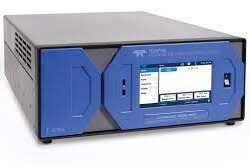Instrument Support Level 2
Teledyne T300U Trace Level
ncas-teledyne-t300u-co-1
£30,000
17.8 cm x 43.2 cm x 59.7 cm, 18kg
44 cm x 59 cm x 79 cm, 25kg
£20
Calendar

TELEDYNE 300U CO Analyser
The Model T300U measures low ranges of carbon monoxide by comparing infrared energy absorbed by a sample to that absorbed by a reference gas according to the Beer-Lambert law.
The optical bench is enclosed in a temperature-controlled oven, dramatically decreasing instrument noise and drift. The objective and field mirrors in the sample cell are gold plated to maximize signal to noise performance, while a temperature controlled Nafion dryer on the inlet minimizes water interference caused by ambient humidity changes. Periodically, the T300U seamlessly corrects its baseline by routing the sample through a heated catalytic CO scrubber. This Auto Reference function corrects zero drift and reduces the effect of interferences.
The instrument is rack mountable and has a calibrated range of 0-1 ppm. It is an ideal instrument for applications such as ambient air monitoring, emission monitoring or in process studies.
Precision 0.5%, Zero noise <10 ppb
The instrument is self-contained and includes a sample particulate filter. A zero trap will be provided to routinely check manually the CO zero for an additional charge of £50. Air is pulled at atmospheric pressure using an internal pump at a flow rate of around 800 ml/min.
We can also provide a logging computer for no extra charge, logs over ethernet.
The instrument will be calibrated before and after deployment using a known amount of CO over a range to check linearity. There is no need to calibrate the instrument in the field.
Consumables
The user will need to supply (otherwise will be charged for):
- Trap containing Sofnocat514
Costs
- Instrument Insurance
- This system must be insured by the user for £30K and covers loss, theft or damage to the instrument: damage is that over and above general wear and tear. The system has been designed to be rugged and autonomous. Even so, the end-user must respect the fact that the system is a precision optical instrument that must be treated with great care.
- The user is responsible for the instrument from the time it leaves the AMOF to the time it is returned and signed off as in an acceptable operating condition by the IS: this will be done as soon as is possible on its return.
- Public Liability Insurance
- The AMOF is not liable for any damage or injury arising from the deployment or operation of this instrument when unattended by the IS.
- Shipping Expenses
- The user is liable for all costs arising from the shipping of the instrument both to and from a deployment.
- IS T&S
- The user is responsible for coving the travel and subsistence expenses of the IS while attending the instrument.
Shipping
The system when packed ready for shipping consists of a single box:
- Shipping dimensions:
- 44 cm (W) X 59 cm (H) X 79 cm (D)
- Shipping weight:
- 25kg
The analyser should be operated from an air conditioned laboratory, measurements taken at atmospheric pressure. A ¼ inch, <5m sampling line should be used for sampling ensuring no water can enter the line. In high humidity conditions the line should be lagged and heated.
Manual handling
- A procedure appropriate to lifting a heavy object should be used when lifting the analyzer. This procedure consists of bending at the knees while keeping your back straight and upright.
- The analyzer should be grasped at the bottom, in the front and at the rear of the unit.
- Do not attempt to lift the analyzer by the cover or other external fittings.
- While one person may lift the unit, it is desirable to have two persons lifting, one by grasping the bottom in the front and the other by grasping the bottom in the rear.
- Cables and sample tubing kept away from pathways; held overhead height if necessary.
- Walkways kept free of clutter and access to exit kept clear.
Electric safety
- Check CO analyser casing, pump and cables are in good condition before switching on.
- Attach all cables to analyser before switching on at the mains. All equipment electrical safety tested.
Attended operation
- There is no requirement for the system to be attended during operation from a safety standpoint.
When unpacked the instrument has the following physical specification
Footprint:
- 17.8 cm (W) X 43.2 cm (H) X 59.7 cm (D)
Weight:
- 18kg
Power:
- 220–240 VAC @ 50/60 Hz, 300 watts
Operation temperature:
- 5 °C to 40 °C in non-condensing environments
The CO analyser provides a measurement of carbon monoxide concentration in ppb.
Field Data
- The instrument produces a range of out files and all are text format.
- The user can download (but not delete) this data from the instrument but it should be noted that this data will not have been quality controlled.
Archive data
- Data is provided in NetCDF files following the AMOF data standard
- Files contain no more than 24hr of data.
- Instrument name is
- ncas-teledyne-t300u-co-1
- The data product(s) associated with this instrument:
- co-concentration
- Example data file
